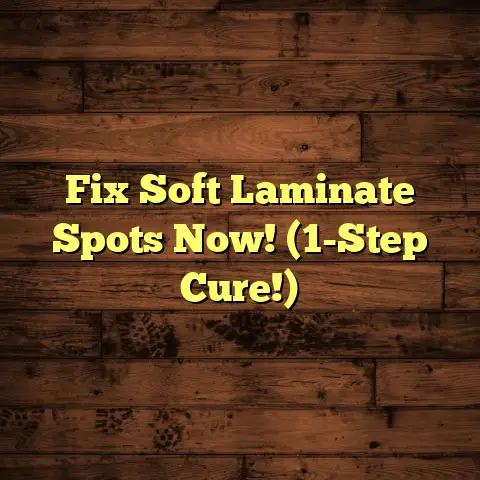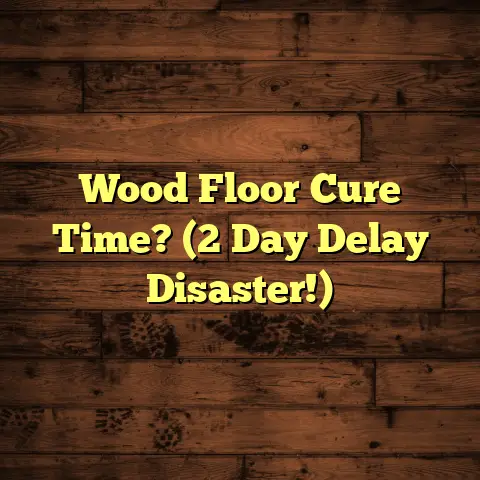Can You Spray Pledge On Wood Floors? (2 Min Warning!)
In a world where cleanliness is synonymous with safety, can the very product designed to enhance the beauty of your wood floors actually compromise their integrity?
As a flooring contractor, I’ve seen it all when it comes to floor care.
And trust me, the question of using Pledge on wood floors is one I get asked a lot.
Let’s dive into whether that shiny spray is a friend or foe to your beautiful wood floors.
Section 1: Understanding Pledge and Its Composition
So, what is Pledge, anyway?
Pledge is a popular household cleaner designed to dust, polish, and protect surfaces.
It’s made by SC Johnson, and it’s been around for decades.
You’ve probably seen it in aerosol cans, liquid sprays, and even as part of multi-surface cleaning wipes.
But what’s in Pledge? That’s where things get interesting.
The exact formulations vary slightly depending on the specific Pledge product, but generally, you’ll find a mix of:
- Silicone oils: These create the shine and help dust resist sticking.
- Solvents: These help dissolve the oils and spread the product evenly.
- Propellants (in aerosols): These create the spray action.
- Water: Acts as a carrier for the other ingredients.
- Fragrance: For that “clean” smell.
- Emulsifiers: Help mix the oil and water-based ingredients.
The key ingredients to pay attention to are the silicone oils and solvents.
While they give that immediate shine, they can cause problems down the road.
Section 2: The Appeal of Using Pledge on Wood Floors
I get it. Pledge is convenient.
It’s easy to grab, spray, and wipe.
It smells nice, and it gives your floors that instant “wow” factor with a noticeable shine.
Plus, it’s readily available at pretty much any grocery store or home improvement center.
Many homeowners also believe it helps repel dust, making cleaning easier in the long run.
I’ve even heard some folks say their grandma always used Pledge, and her floors looked great!
(Though I’m always a little wary of “grandma’s secret” when it comes to floor care.)
Anecdotally, some people do have positive experiences with Pledge, particularly on older, more durable wood finishes.
They might say it helps hide scratches or gives the floor a fresh look between professional cleanings.
However, personal experience isn’t always the best guide.
What works on one floor might be a disaster on another.
And that’s where the risks come in.
Section 3: The Risks Associated with Using Pledge on Wood Floors
Alright, let’s talk about the potential downsides.
This is where my experience as a flooring contractor really comes into play.
The biggest issue with Pledge is the residue buildup.
Those silicone oils I mentioned?
They don’t evaporate.
Over time, they can create a waxy layer on your floors.
This layer attracts dirt, making your floors look dull and grimy even after cleaning.
Think of it like hairspray.
Use too much, and your hair becomes stiff and sticky.
Pledge can do the same thing to your floors.
Another risk is slickness.
That shiny surface can become incredibly slippery, especially for kids, pets, or anyone with mobility issues.
I’ve seen firsthand the accidents that can happen on overly polished floors.
But the most concerning risk is potential damage to the finish.
The solvents in Pledge can react with certain types of wood finishes, especially polyurethane.
This can lead to clouding, discoloration, or even peeling of the finish.
According to the National Wood Flooring Association (NWFA), using the wrong cleaning products can void your floor’s warranty.
That’s a costly mistake!
Section 4: Comparing Pledge with Other Wood Floor Cleaners
So, how does Pledge stack up against other wood floor cleaners?
Let’s be clear: Pledge is not a dedicated wood floor cleaner.
It’s a multi-surface product designed for furniture, cabinets, and other surfaces.
Dedicated wood floor cleaners, on the other hand, are specifically formulated to be safe and effective for wood.
They typically have a neutral pH balance, which means they won’t damage the finish.
They also contain ingredients that help lift dirt and grime without leaving behind a residue.
Here’s a quick comparison table:
Some excellent alternatives to Pledge include:
- Bona: A popular and well-respected brand known for its wood floor cleaning solutions.
- Murphy Oil Soap: A classic choice, but be sure to dilute it properly.
- Vinegar and water: A natural and effective option for light cleaning (use sparingly).
Important Note: Always check the manufacturer’s recommendations for your specific type of wood flooring before using any cleaning product.
Section 5: Best Practices for Wood Floor Maintenance
Alright, let’s get down to the nitty-gritty of proper wood floor care.
Here’s my advice, based on years of experience:
- Sweep or vacuum regularly: This is the most important step.
Remove dirt and debris before they can scratch your floors. - Use a microfiber mop: Microfiber mops are gentle and effective at picking up dirt and grime.
- Choose the right cleaner: As we’ve discussed, avoid Pledge and opt for a dedicated wood floor cleaner.
- Mop sparingly: Don’t saturate your floors with water.
A damp mop is all you need. - Dry your floors: After mopping, dry your floors with a clean towel to prevent water spots.
- Protect your floors: Use rugs in high-traffic areas and felt pads under furniture legs.
- Avoid harsh chemicals: Never use bleach, ammonia, or abrasive cleaners on wood floors.
- Consider a professional cleaning: Every year or two, have your floors professionally cleaned to remove buildup and restore their shine.
Here’s a table summarizing the best practices:
I always tell my clients that proper maintenance is the key to extending the life of their wood floors.
A little bit of care goes a long way.
Section 6: Conclusion
So, can you spray Pledge on wood floors?
The answer, in my professional opinion, is generally no.
While it might seem like a quick and easy solution, the risks outweigh the benefits.
The potential for residue buildup, slickness, and finish damage simply isn’t worth it.
Remember that paradox we started with?
The product designed to enhance your floors might actually be harming them.
Ultimately, the choice is yours.
But I encourage you to consider the long-term effects of your cleaning choices.
A beautiful floor is an investment, and it deserves to be treated with care.
What cleaning products are you using on your wood floors?
Are you sure they’re the best choice?
Maybe it’s time to rethink your cleaning routine and give your floors the love they deserve.





